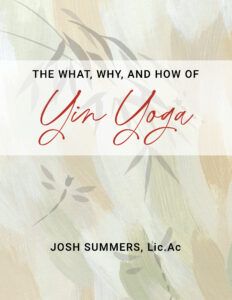Before practicing, it’s important to familiarize yourself with the four main principles of Yin Yoga. Please read through the following at least a few times to ensure you are practicing safely and intelligently.
The first principle of Yin Yoga is to come into a posture and play the edge of appropriate sensation. Upon entering the pose, begin at your first edge of resistance. From that mild edge of sensation, observe what is being felt. Sensation should be no more than a mild and moderate sensation of stretch or pressure. Nothing in the range of sharp, stabbing, aggressive sensation should be tolerated. If you experience strong discomfort or pain, please back off from the pose, re-evaluate your alignment, and/or come out of the pose entirely.
The second principle of Yin Yoga is to relax the muscles in the area you’re intending to target. With the muscles relatively relaxed, the stress will transfer to the dense connective tissues in and around that specific region. You may find that there are multiple target areas within one pose, and that’s completely normal. The targeted experience may also change and shift throughout the duration of the hold.
The third principle of Yin Yoga is to remain relatively still for a relatively longer period of time. Postures can be held anywhere from three to six (or more) minutes, but start with a time frame that makes sense for you, honoring the previous principles. Keep in mind, you are not fixed to a single spot for the duration of the pose. It is important to change the angle or depth of the pose to accommodate for any release, or it is important to back away from an edge of sensation that becomes too intense. Remaining relatively still in a pose does not supersede the importance of skillfully playing your edge.
Lastly, the fourth principle of Yin Yoga is to enter and exit all poses slowly. Be sure to release each pose with care. There will likely be a sense of fragility in the area of the body that received the gentle stress of the Yin postures. Move slowly and mindfully as you transition out of the poses.
Practice the postures in the sequence, allowing for 3-6 minutes in each pose. Be certain to honor the principles of the practice, and release sooner or change the angle of the pose if you experience pain or sharp sensations. The descriptions for each pose are meant to serve as a starting suggestion, and these suggestions are simply the beginning stages of exploration within the Yin Yoga practice. All practitioners are encouraged to experiment, modify, and customize every pose to suit their unique body. Feel free to creatively modify the basic idea, and be sure to give yourself at least 1-2 minutes between postures to rest while observing the effects.
Disclaimer: Not all yoga poses are suitable for all people. Always consult your health care provider and obtain full medical clearance before practicing yoga or any other exercise program. The information provided in this blog is strictly for reference only and is not in any manner a substitute for medical advice or direct guidance of a qualified yoga instructor.

